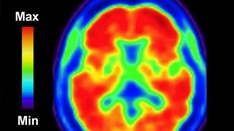Practice Essentials
Signs and symptoms
Vascular dementia is a heterogeneous entity with a large clinicopathological spectrum that has been classically linked to cortical and subcortical ischemic changes resulting from systemic, cardiac, or local large- or small-vessel disease occlusion.
Symptoms of vascular dementia include the following:
-
Memory impairment
-
Impairment in at least 1 other cognitive domain (eg, orientation, language, praxis, executive functions, visuospatial abilities)
-
Worsening of cognitive abnormalities
-
Impact on activities of daily living
In a clinical setting, differences between the cognitive disturbances in vascular dementia and Alzheimer disease are of limited value in distinguishing the 2 conditions. Patients with dementia and vascular disease frequently have mixed pathology (ie, both Alzheimer disease and vascular dementia; “mixed dementia”). [1, 2]
Vascular dementia may have less significant memory dysfunction than Alzheimer disease. [3] It is also thought that frontal dysfunction due to widespread involvement of subcortical structures in vascular dementia may lead to a dysexecutive syndrome with abulia and apathy. In contrast, a cognitively impaired patient with vascular risks factors but no history of cerebrovascular disease is most likely to have Alzheimer disease. One study highlighted the interaction of environmental and genetic factors contributing to the predisposition to vascular dementia. [4]
See Clinical Presentation for more detail.
Diagnosis
The diagnosis of vascular dementia is usually made on the basis of clinical, neuroimaging, or neuropathologic evidence of cerebral ischemia in the presence of progressive cognitive decline.
Examination for vascular dementia includes the following:
-
Evaluation of the temporal arteries: Decreased pulsatility, local tenderness, and thickening associated with giant cell arteritis may be noted [5]
-
Funduscopic evaluation: End-organ effects of hypertension and diabetes mellitus may provide important information
-
Cardiac auscultation: Cardiac rhythmic and valvular abnormalities may be detected
-
Neurologic assessment: Spasticity, hemiparesis, visual field defects, pseudobulbar palsy, and extrapyramidal signs confirm focal pathology
-
Cognitive assessment with a standardized tool (eg, Mini Mental Status Examination, Short Blessed questionnaire): Low scores may provide corroborative evidence of a cognitive disturbance
Testing
All patients with dementia should have laboratory testing to rule out reversible causes of dementia. The following studies may be useful for identifying or excluding other disorders:
-
Complete blood count (CBC)
-
Electrolyte levels
-
Thyroid-stimulating hormone (TSH) levels
-
Folate and vitamin B-12 levels
The American Academy of Neurology no longer recommends syphilis screening in the routine evaluation of dementia if patients come from geographic regions with a very low base rate of syphilis. In specific cases, screening for syphilis is indicated.
If the clinician has reason to suspect an angiitis affecting cerebral vessels, then an erythrocyte sedimentation rate (ESR) and specific panels may be ordered.
Imaging studies
In patients with newly diagnosed dementia, obtain neuroimaging studies (ie, CT scanning or MRI of the head) to rule out treatable causes of dementia and to aid in the differential diagnosis. The following findings may be observed:
-
Vascular dementia: Multiple cortical, and more commonly subcortical, infarcts or single strokes affecting the thalamus, angular gyrus, and the territory supplied by the anterior cerebral arteries
-
Dementia: Decreased white-matter density on CT scanning or decreased T1 or increased T2 signal intensities on MRI; multiple pathologies, including small vessel disease and decreased integrity of the blood-brain barrier, have been associated with these findings
See Workup for more detail.
Management
Nonpharmacologic strategies may help with behavior problems in patients with vascular dementia. [6, 7] No approved pharmacologic treatment exists for vascular dementia, so pharmacologic therapy is directed toward risk factors or symptoms.
Treat patients with risk factors for cerebrovascular disease. The individual approach combines a vascular risk factor modification and various therapies addressing the specific subtypes of stroke (eg, antiplatelet drugs to prevent cerebral infarction in large and small artery diseases of the brain, carotid endarterectomy or stenting for tight carotid artery stenosis, and oral anticoagulants to prevent cardiac emboli). [8]
Administer antiplatelet agents when indicated, depending on the nature of the patient's underlying vascular pathology. Management of vascular disease and dementia in a young patient with suspected uncommon causes of stroke (eg, cerebral autosomal dominant arteriopathy with subcortical infarcts and leukoencephalopathy [CADASIL] or angiitis) involves ruling out these conditions with the appropriate testing procedures (ie, skin biopsy, cerebral angiography). The decision to use anticoagulation therapy in these patients may be challenging due to the increased risk of falls and potential noncompliance in this group.
Manage behavioral and psychiatric disturbances such as depression and psychosis with serotonin reuptake inhibitors. In patients with agitation, environmental modification and/or pharmacologic intervention with sedation can be useful.
There is limited evidence that cholinesterase inhibitors (eg, donepezil, rivastigmine, galantamine) may have a role in the treatment of vascular dementia. These agents have proven symptomatic efficacy in Alzheimer disease, and their use in vascular dementia may have some justification given the prevalence of dementia with mixed pathology.
Although lipid-lowering agents given in late life have not demonstrated a reduction in the risk of cognitive decline and dementia, women who are treatment-resistant for high levels of low-density lipoprotein (LDL) cholesterol may be at increased risk of decline in visual memory. [9]
See Treatment and Medication for more detail.
Background
Dementia is a common neurologic syndrome with significant impact on the mortality and morbidity of elderly persons with the most common forms being Alzheimer disease and vascular dementia. Vascular dementia is a heterogeneous entity with a large clinicopathological spectrum that has been classically linked to cortical and subcortical ischemic changes resulting from systemic, cardiac, or local large- or small-vessel disease occlusion. Thus, the diagnosis of vascular dementia is usually made on the basis of clinical, neuroimaging, or neuropathological evidence of cerebral ischemia in the presence of progressive cognitive decline. On the other hand, vascular pathology often coexists with Alzheimer disease [1, 2] , and this poses an additional diagnostic challenge. This has led to the existence of the diagnostic term of mixed dementia.
This diagnosis is made in the presence of neuropathologic hallmarks of Alzheimer disease such as accumulation of extracellular amyloid plaques, intracellular neurofibrillary tangles, and cerebral amyloid angiopathy as well as evidence of significant ischemic events. Significant associations between both, deep white matter and periventricular hyperintensities, and focal atrophy of medial temporal lobe structures have been described. These findings might indicate that not only vascular factors alone but also degenerative factors favor the occurrence of white matter hyperintensities after the age of 75 years. [10]
The frequent coexistence of Alzheimer disease and vascular dementia pathologies in postmortem studies has led many to suggest that these 2 entities are mechanistically related. Further evidence for this comes from the significant overlap in risk factors for Alzheimer disease and vascular disease such as hypertension, diabetes, and apoE4 genotype. In one study, Alzheimer's disease with cerebrovascular disease was found to be under-recognized in Asia. Authors have proposed the need for future research to establish the true prevalence of this treatable and potentially preventable disease. [11] Furthermore, cerebral hypoperfusion as detected by positron emission tomography (PET) has been demonstrated in early stages of Alzheimer disease. Also cerebral amyloid angiopathy, which is prevalent in Alzheimer disease brains, could further alter cerebral hemodynamics. Despite these observations, the mechanisms of vascular-Alzheimer disease interactions are poorly understood, and the question remains as to whether these two entities interact in a synergistic fashion.
Pathophysiology
Vascular dementia results from brain injury caused by stroke and cerebral ischemia.
Single ischemic or thromboembolic infarcts occurring in strategic areas of the dominant hemisphere (eg, angular gyri, mediodorsal thalamus, anterior thalamus) may cause a dementia-like syndrome without the involvement of large volumes of cerebral matter. In general, volume of tissue loss is a poor predictor of the severity of the cognitive impairment.
More commonly, progressive cognitive deficits and dementia can result from multiple temporally staggered small cerebral infarcts. Frontal subcortical regions supplied by small penetrating arterioles may be especially prone to degenerative changes in patients with poorly controlled hypertension, diabetes mellitus, or both.
A less common cause of vascular dementia is global hypoxic-ischemic injury (eg, following cardiac arrest). Irreversible cognitive impairment is frequently observed following coronary bypass surgery. [12]
Whether chronic cerebral ischemia associated with carotid artery stenosis (CAS) may alter cognitive function has not been conclusively demonstrated and remains a controversial concept. Neuropsychometric evaluation of patients undergoing carotid endarterectomy has not conclusively shown cognitive impairment or reductions in the probability of developing dementia in the long term.
An ill-understood form of vascular dementia is Binswanger encephalopathy. Postmortem, myelin loss is observed and is most prominent in the hemispheric deep white matter. Axonal drop out is also observed with little or no signs of inflammation. Neuroimaging shows decreased white matter density on CT scanning and decreased white matter intensity on T1-weighed MRI. Frequently, but not invariably, lacunar strokes are also observed.
Dementia associated with cerebrovascular disease is also observed in a rare genetic condition, ie, cerebral autosomal dominant arteriopathy with subcortical infarcts and leukoencephalopathy (CADASIL). [13] Affected patients often present with migraines with aura. Recurrent strokes start when the patients are aged 30-50 years. Multiple lacunar infarcts, mainly in the frontal white matter and basal ganglia, lead to progressive cognitive decline and finally dementia. However, cognitive decline is thought to begin even before strokes occur, suggesting that chronic cerebral hypoperfusion in the absence of overt stroke might be sufficient to cause significant neuronal circuit disruption.
Lastly, cognitive decline has been reported in association with several other vasculopathies such as temporal arteritis, polyarteritis nodosa, primary cerebral angiopathy, lupus erythematosus, and moyamoya disease.
Qian et al looked into early biomarkers for poststroke cognitive impairment. They revealed that only ß-secretase enzyme and soluble receptor levels for advanced glycation end products, not neprilysin or APOE genotypes, may be biomarkers diagnosing poststroke cognitive impairment. [14] . Chronic high blood pressure via its changes to the cerebral vasculature including cerebral arterial stiffening and microvascular dysfunction, leads to increasing impairment of Aβ clearance. This, in essence, can cause Aβ deposition in the brain. [15]
Epidemiology
Frequency
United States
The overall incidence of vascular cognitive impairment or vascular dementia ranges between 10% and 40% with most accepted figures around 20%. This variability is likely to be due to uneven diagnostic criteria used in different studies. Furthermore, the diagnosis requires clinical, neuroimaging, or neuropathological evidence of ischemic events. This may lead to an underestimation of the role of microvascular occlusion and chronic hypoperfusion, which are difficult to detect in routine neuropathological examination. Therefore, the incidence of vascular cognitive impairment may be higher than currently thought.
The incidence of dementia associated with acute stroke may be high, with 10-35% of patients developing dementia within 5 years following a hemispheric stroke. Patients with symptomatic hemispheric strokes have an approximate 4-fold increase in the risk of dementia compared with age-matched controls.
International
Incidence of vascular dementia in Southeast Asia may be greater than in Western countries because of a higher incidence of cerebrovascular disease in that part of the world. For example, in Japan, 50% of cases of dementia are thought to have a vascular etiology. However, geographic differences may reflect diagnostic biases rather than true epidemiologic differences.
Mortality/Morbidity
Median survival depends on whether cognitive decline follows a single large hemispheric stroke or instead is the result of slowly progressive cognitive decline resulting from microvascular pathology. The progression of vascular cognitive impairment is highly variable. In general, when vascular dementia occurs shortly after large hemispheric strokes, the mortality is relatively high (around 4 y). [16]
Race
In the United States, individuals of African descent have a higher incidence of dementia than whites. Vascular dementia may be the most common type of dementia affecting blacks.
Sex
Incidence of vascular dementia is higher in males than in females. The converse is true for Alzheimer disease. This difference probably reflects known sex differences in the incidence of cerebrovascular disease.
Age
The incidences of vascular dementia and Alzheimer disease increase similarly with age.









